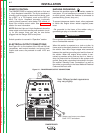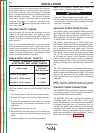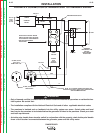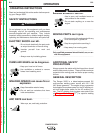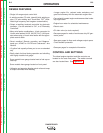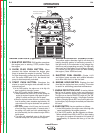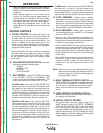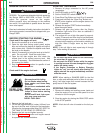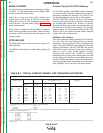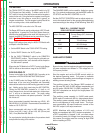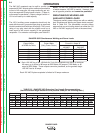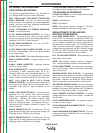
Return to Section TOC Return to Section TOC Return to Section TOC Return to Section TOC
Return to Master TOC Return to Master TOC Return to Master TOC Return to Master TOC
OPERATION
B-5 B-5
RANGER 305D
CV-WIRE mode: In this mode, turning the ARC CONTROL
clock wise from –10 (soft) to +10 (crisp) changes the arc
from soft and washed-in to crisp and narrow. It acts as an
inductance/pinch control. The proper setting depends on the
procedure and operator preference. Start with a setting of 0.
12. 14-PIN AMPHENOL: Primarily used for attaching
accessories, such as a wire feeder, spool gun module or
TIG module. It provides connections to both 120VAC and
42VAC power, and to the weld circuit work voltage sensing
lead. It also provides a connection to the same control cir-
cuits described in the 6-PIN AMPHENOL section below.
13. 6-PIN AMPHENOL- Primarily used to connect a
remote control device, such as the K857, or a TIG Amptrol,
such as the K870 or K812.
Both the 6 and 14-Pin amphenols are connected to a
remote control auto-sensing circuit that transfers all or par-
tial output control functions from the front panel output con-
trol dial to the remote output control device.
When in TOUCH START TIG mode, a remote output con-
trol device will vary the output from MIN up to the value set
with the front panel output control dial. In all other modes,
the front panel output control is completely disabled, and
full MIN to MAX control is transferred to the remote output
control device.
Both Amphenols also connect to an electronic output con-
tactor circuit. When the “Weld Terminals” switch is in the
“remotely controlled” position, the weld terminals are
switched on an doff by the device connected to either
amphenol.
NOTE: Both the 6 pin and 14 pin Amphenols share the same
output control auto-sensing and contactor circuitry; for
this reason, there can only be one device plugged into
the Ranger 305D at any time.
14. WELD TERMINALS CONTROL SWITCH- In the
WELD TERMINALS ON position, the output is electrically
hot all the time. In the REMOTELY CONTROLLED posi-
tion, the output is controlled by a wire feeder or amptrol
device, and is electrically off until a remote switch is
closed.
15. WIRE FEEDER VOLTMETER SWITCH:
Matches the polarity of the wire feeder voltmeter to
the polarity of the electrode.
16. DIGITAL OUTPUT METERS:
The digital meters allow the output voltage (“CV-
WIRE” mode) or current (“CC-STICK”, “DOWNHILL
PIPE” and “TOUCH START TIG” modes) to be preset
prior to welding using the output control dial. When
pre-setting voltage the AMPS display will be off and
while pre-setting amps, the VOLTS display will be off.
While welding, the machine display both the actual
voltage (VOLTS) and current (AMPS).
• When the electrode touches the work or power is
drawn for lights or tools (approximately 100 Watts
minimum), the engine accelerates and operates at
full speed.
• When welding ceases or the AC power load is
turned off, a fixed time delay of approximately 12
seconds starts. If the welding or AC power load is
not restarted before the end of the time delay, the
idler reduces the engine speed to low idle speed.
• The engine will automatically return to high idle
speed when there is welding load or AC power load
reapplied.
WELDING CONTROLS
9. OUTPUT CONTROL: The output control dial is used
to present the output voltage or current as displayed on
the digital meters for each of the four welding modes. It
can also be used to vary the output while welding. This
control is disabled by an auto-sensing circuit if the
machine is in CC-Stick, Downhill pipe, or CV-wire modes,
and an accessory device with output control capability is
plugged into either amphenol.
When in Touch-Start TIG mode, and when an accessory
device with output control, such as an Amptrol, is plugged
in to either Amphenol, the OUTPUT control dial is used to
set the maximum current range of the accessory output
control device.
10. WELD MODE SELECTOR SWITCH: This switch
provides four selectable welding modes:
- CV-WIRE
- DOWNHILL PIPE
- CC-STICK
- TOUCH STARTING
11. ARC CONTROL- The ARC CONTROL dial is active
in the CV-WIRE, CC-STICK, and DOWNHILL PIPE
modes, and has different functions in these modes. This
control is not active in the TOUCH START TIG mode.
CC-STICK mode: In this mode, the ARC CONTROL dial
sets the short circuit current (arc-force) during stick weld-
ing to adjust for a soft or crisp arc. Increasing the dial from
–10 (soft) to +10 (crisp) increases the short circuit current
and prevents sticking of the electrode to the plate while
welding. This can also increase spatter. It is recommend-
ed that the ARC CONTROL be set to the minimum num-
ber without electrode sticking. Start with a setting at 0.
DOWNHILL PIPE mode: In this mode, the ARC CON-
TROL dial sets the short circuit current (arc-force) during
stick welding to adjust for a soft or a more forceful digging
arc (crisp). Increasing the number from –10 (soft) to +10
(crisp) increases the short circuit current which results in a
more forceful digging arc. Typically a forceful digging arc
is preferred for root and hot passes. A softer arc is pre-
ferred for fill and cap passes where weld puddle control
and deposition ("stacking" of iron) are key to fast travel
speeds. It is recommended that the ARC CONTROL be
set initially at 0.



